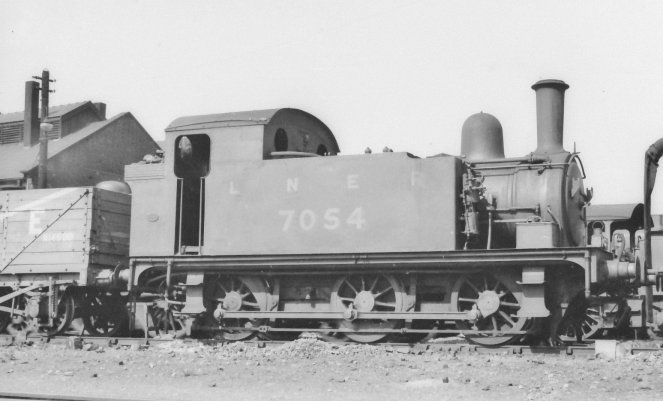Part 1– Let battle commenceSo at last, as promised, I return to the construction of the J65 and J69, if rather later in the day/month/year/decade than I intended when I wrote the last post. You may need to do some revision to remember where we had got to, but don’t get too excited yet. Before we actually build anything we better have a good think about the exact prototype we want to produce and do some basic planning.
Having arrived at the position that I was going to set about both the J65 and the J69, it was obvious to me that I should do the two in parallel. I generally find batch building improves the speed of progress, from glacial to snail’s pace its true but it is an improvement. They were, after all, very similar prototypes and both kits were produced originally under the Riceworks banner. I got my J65 kit direct from President Ian mumble mumble years ago, but the J69 came from London Road Models much more recently. Both are etched kits with lost wax and white metal castings, and a brass Tube cut to length for the boiler. Reading both sets of instructions in parallel gives you a very distinct sense of dèjá vu.
The PrototypeBefore I started building I thought I should have a fair idea what the particular locos I was going to build would looked like, especially as I was building Stratford prototypes that underwent a significant amount of detail change over time. My chosen date is 1934, and given the set of fixtures and fittings I wanted to include, I tried to find two locos that fitted the bill. This didn’t prove all that easy and I soon realised that some of my original ideas could easily have produced a historical anomaly. After a lot of head scratching, compromise and consideration I settled on the following.
The J65No 7155 as it would have looked in early 1934 just before it had a boiler change.
One of the first 10 built in 1889 to order E22, and one of the last survivors not being withdrawn until 1953.
4’0” 10 spoke cast steel wheels with distinctive balance weights (infill between spokes rather than crescents).
Strait brake pull rods.
Low roof (7155 never got a high one)
Diagram 36 boiler, with twin column Ramsbottom Safety valve, over the firebox and with the whistle on the same seating as the safety valve
Stovepipe Chimney
Westinghouse fitted
In filled coal rails
Blower valve on the smoke box controlled by a rod running above the hand rail
Tool box on left tank top hard against the cab
GER parallel buffers
Steam heating fitted with “bags” on, it must be winter.
Running as a 2-4-0, as it did for much of its life. To start with I assumed it had reverted to a 0-6-0 when it stopped working the Blackwall service just like most of it classmates, and it was quite late on that I realised that the photo evidence suggested otherwise. The decision to go 2-4-0 was taken quite late and the chassis was originally built as an 0-6-0 as some of the pictures will show,
There is a good picture at the right period on Page 20 of Yeadon Vol 48, also several others at different dates.
The J69No 7054 in early 1934, not long before it acquired a high cab roof.
One of the first 10 built to order S56 in 1904, sold to the MOD in 1940, and sold again into industry in 1946. Scraped 1954.
4’0” 10 spoke cast steel wheels with crescent balance weights.
Strait brake pull rods
Originally fitted with condensing gear but this was blanked off in 1930
Diagram 37 boiler with Ross pop safety valves forward of the firebox, whistle mounted close to the cab font.
NE pattern Chimney
Low Cab roof
Westinghouse and Vacuum fitted
Injectors behind cab step
Blower valve control through left hand handrail
No tool box
LNER Standard stepped buffers
Again Steam heat ready.
Picture in RCTS vol 8A Fig 92.but with high roof fitted post 1934.

The logical first step was to do the chassis. Those who know me will realise that this implies we are off to the land of CSB suspension. I decided that the order of play would be, to do the basic rolling chassis first, then build up the body to the point where the space available for the drive train was well understood, then complete the chassis, drive train, pickups and all before completing of the body shell.
Information UsedTo support this build, the most important sources I used were
Yeadon’s Register of LNER Locomotives Volume 48
RCTS Locomotives of the LNER Part 8A
MRJ 35 &36 Ian Rice's article “In Search Of The Buckjumpers”. Including Lyn Brooks drawing for the GER society of the R24 and R24R variants of the J67/9s
Model Railways, March 1972 portrait of a Locomotive No 87 (S56) including Bernard Wright’s sketches of various parts of the preserved example.
And Finally and perhaps a little late in the day, the John Gardner loco drawings, derived from the Stratford originals, and published by the GER society. These became avaible available in 2020 as a full downloadable collection that covers most GER locos in general and Buckjumpers of all varieties in particular.
Edited to add the John Gardner drawings to the Information Sources used
